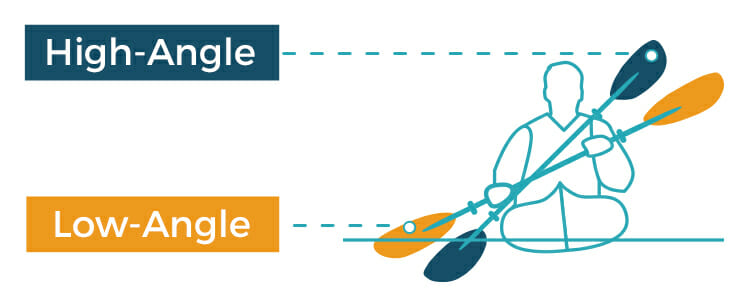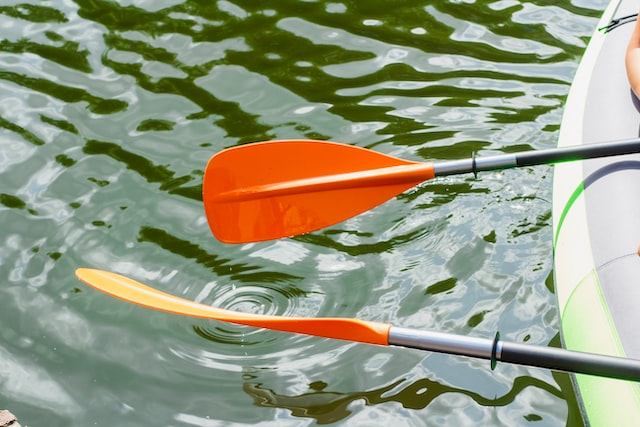Your kayak paddle is the most important piece of equipment after your kayak (read here our guide on buying the perfect kayak). It has a serious impact on both your performance and how much you enjoy your time on the water.
While there are tons of options available, choosing a paddle doesn’t have to be difficult. Once you know the important points to consider and the pros and cons of various features, you’ll be able to narrow down the sea of options to just a handful of paddles that best fit your needs and budget.
Paddle Length
When choosing a paddle the first and most important thing to get right is its length.
Problems that come with an incorrectly sized paddle:
- The blade won’t reach the water without having to lean over
- Banging your knuckles against the side of the kayak
- Extra weight
- Less control while paddling
The key points to consider when sizing your paddle are:
- Kayak width
- Paddler height
As a rule, wider kayaks and taller paddlers require longer paddles. Each manufacturer recommends slightly different lengths but the chart below should give you a pretty good idea of where you stand. Just bear in mind that paddle length is measured in centimeters rather than inches.
Paddle Sizing Chart
| Kayak Width | Under 23” | 24” to 28” | 29” to 33” | 34”+ |
|---|---|---|---|---|
| Paddler Height | ||||
| Under 5’ 5” | 210 cm | 220 cm | 230 cm | 240 cm |
| 5’ 5” to 5’ 11” | 220 cm | 230 cm | 240 cm | 250 cm |
| 6’+ | 230 cm | 240 cm | 250 cm | 260 cm |
Kayak Width
It’s worth measuring the width of your kayak or looking it up on the manufacturer’s website for the best possible fit. But as a reference, here are the typical widths of various types of kayaks.
| Recreational | Touring | Sea | Fishing | Inflatable | |
| Width | 27” – 36” | 23” – 27” | 19” – 23” | 30” – 40” | 30” – 40” |
Just the width of your kayak and your height will give you a pretty accurate idea of your ideal paddle length.
However, it’s also a good idea to take into account your seat height and the angle of your paddle stroke.
Seat Height
Some sit-on-top kayaks have seats that sit particularly high above the level of the water. This is common among fishing kayaks that have both high and low seating positions.
If you paddle from a high seating position, you may want to consider adding 10 cm to compensate for the increased distance from the water.
Low-Angle vs High-Angle Paddle Strokes

There are two broad styles of paddling:
- Low-Angle – More relaxed and ideal for touring and casual recreational paddling. It’s not as powerful but also won’t tire you out as quickly. Low-angle paddling requires a longer paddle.
- High-Angle – More aggressive paddling style suited to more demanding conditions or for generating more powerful strokes. High-angle paddling requires a shorter paddle.
Low-angle paddling is the most common style. Most paddlers will default to a low-angle stroke without even thinking about it as it’s more comfortable.
Ideally, a manufacturer will specify whether their size charts are geared towards low or high-angle paddling, but some won’t. If they don’t, there’s a good chance their chart is based on low-angle paddling and you may want to subtract 10 cm if you prefer a high-angle stroke.
Blade Design
When considering the design of your paddle blade, you want to think about both its shape and size. The material it’s made of is also important but we’ll cover that in a bit.
Blade Shape
You can choose between low-angle or high-angle blades based on what kind of paddler you want to be.
Low-angled blades are more comfortable for casual kayakers because they’re narrow and long while having less power. High Angles allow users who prefer a racing style – short but wide designs offer greater control when rowing at higher speeds.
Dihedral vs Spoon
Dihedral and spoon are the most common paddle shapes you’ll see. Most kayakers find dihedral blades more comfortable.
You can spot a dihedral blade by the ridge that runs along its center. The ridge helps water flow evenly over the surface of the blade, which prevents it from fluttering and makes for more comfortable paddling.
Spoon blades scoop the water and offer a better bite. The downside is that they tend to flutter quite a bit if your paddling technique isn’t perfect. You’re probably better off with a dihedral blade unless you’re committed to nailing down your technique.
Asymmetrical vs Symmetrical
Most kayak paddles have an asymmetrical shape with the top edge of the blade being longer than the bottom. This helps keep the water pressure on the top and bottom of the blade even and prevents the shaft from twisting in your hands.
Symmetrical blades are more common for non-kayaking paddles but some budget kayak paddles may use them. You’re generally better off with an asymmetrical blade for kayaking if it’s in your budget.
Blade Size
Larger blades have more surface area and will offer more bite while paddling. They’ll be able to generate more power but that doesn’t necessarily mean you should go for the largest paddle blade you can find.
Moving a larger blade through the water requires more strength and puts more strain on your body. So, paddlers that aren’t as strong or have a smaller frame are usually better off with a smaller blade.
Having said that, larger blades can be an advantage if your kayak is very heavy or loaded down with a lot of gear.
| Small | Medium | Large | |
| Blade Size | Under 90 in² (580 cm²) | 90 – 100 in² (580 – 645 cm²) | Over 100 in² (645 cm²) |
Materials
The material a paddle is made of has a significant impact on its:
- Weight
- Performance
- Durability
- Price
Weight – You can spend more time on the water and paddle more with less effort if your paddle is lighter. Even while losing a pound may not seem like much, it builds up over the course of many hours and countless strokes of paddling.
Performance – More rigid materials allow you to paddle with greater efficiency and create a more forward motion. Materials that are flexible don’t hold their shape as well when moving through the water, so they require fewer strokes for someone who is paddling compared with somebody using firmer alternatives.
Durability – Though there are some exceptions, better materials are often harder and can withstand misuse better than inferior materials.
Cost – As with most things, better materials come at a higher price. Here are the most typical material combinations, listed from least expensive to most expensive:
- Aluminum shaft and plastic blade
- composite shaft and reinforced plastic blade
- a composite shaft and blade
Blade Materials
‘Plastic’ and ‘composite’ are used in a generic sense. There are a number of plastics used in paddle blades with the most common being nylon and polypropylene. Composites refer exclusively to either fiberglass or carbon fiber.
- Plastic/plastic reinforced with fiberglass – These blades are the most affordable you’ll find. They don’t function very well because they are the heaviest and most flexible blades. Recreational kayak paddles are the most typical type of paddle to have plastic blades. Performance and durability can be increased by adding fiberglass to plastic blades but not to the same extent as full composite blades.
- Fiberglass – Fiberglass blades offer excellent durability and performance but are significantly cheaper than carbon fiber. They’re a good fit for more committed recreational paddlers or those looking to start out with touring, as they have some flexibility which makes them less likely to break on rock impacts while still providing top-notch power when needed most!
- Carbon fiber – Blades made from carbon fiber are the lightest and highest performance ones you’ll find. They’re not cheap but are your best bet if you’re looking for an ultralight performance paddle. While carbon fiber is a very strong material, blades made of carbon fiber are typically made to be as light as possible and can be a little more susceptible to sharp impacts compared to fiberglass blades.
Shaft Materials
- Aluminum – Aluminum shafts really have a fairly long lifespan and are easy on the wallet. The drawback is that, depending on the weather, they can be uncomfortable to hold. If you are paddling in chilly water, you should give this some thought.
- Fiberglass & carbon fiber – Composite materials make for the most lightweight and highest-performance shafts. Carbon fiber does have an edge but, as with blades, you’ll pay a premium for it. Both fiberglass and carbon fiber do an excellent job insulating your hands from the water temperature.
Shaft Design
- Straight vs Bent – The majority of paddlers are familiar with straight shafts. However, a bent shaft is something to think about if you paddle frequently or have wrist pain. It places your wrists in a more neutral position during your stroke, which puts less strain on them. Unfortunately, they tend to be fairly expensive.
- Diameter – Shafts will either come in a standard or small size. Most paddlers are better off with a standard shaft but if you have smaller hands try a small-diameter shaft. You want a fairly relaxed grip to reduce fatigue while paddling, which is hard to do if the shaft is too large for your hands.
- Feathering – The majority of shafts let you “feather” your paddle blades, which offsets them from one another. Although it takes some getting accustomed to, paddling with offset blades can dramatically lessen the wind resistance of your upper blade as it moves through the air. Some paddles allow for only one preset feathering angle while other paddles will allow you to set a customized angle.
- Two-piece vs four-piece – The standard is for paddles to break down into two pieces for easier transportation and storage. If you want some extra portability or plan to fly with your paddle, many paddles also come in a four-piece configuration that packs down to a smaller size.
- Adjustable length – Some paddles have the ability to adjust their length. The adjustment is usually about 15 cm and could be a good option if you have multiple kayaks of different widths or the paddle will be used by paddlers of different heights. It’s also a handy feature if your kayak’s seat is adjustable between a low and high position as is commonly found in fishing kayaks.


